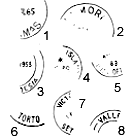A SPECIAL OF
PHILATELIC EXPERTS,
|
|
1. Bahamas,
1965 |

(Click for larger image.) |
The hand stamps
are probably made of old time zincographs. It is possible that the forger only had partial devices and that no full
strikes can exist. The date, when not chiselled out, is fixed. Sometimes the
place name is also made illegible. The types of the postmarks are usually
too old (pre-1960) for the stamps in question – used on older items too? A
general advice: try to check if the name of the post office fits the stamp.
THE AMERICAN CASE
The January 1996 issue of The American Philatelist contained a fake alert
regarding forged post-war British Commonwealth postmarks. Attached are all
the
images of the original impressions. The countries involved are: Antigua, Bahamas,
Barbados, Cape of Good Hope, Bermuda, Br. Guiana, Br. Honduras, Cayman Is.,
Dominica, St. Lucia, Falkland Is., Fiji, Gambia, Grenada, Jamaica, Malta,
Mauritius, Montserrat, N. Rhodesia, St. Kitts, St. Vincent, Seychelles,
Somaliland, Swaziland, Solomon Is., Trinidad, Turks & Caicos Is., Br. Virgin
Is.
This is not the same forger as the British one. These forgeries are
more dangerous as the convincing postmarks (45 different) were probably applied to the correct stamps in
full or large part strikes, or on items of postal history. The illustrations show mainly complete postmarks. The
British West Indies dominate, so the devices, which have fixed dates, were
presumably made in the USA, where most of the fakes certainly would be located.
The American Philatelist only says that the devices were found in the estate
of a deceased dealer in British area material.
The
Madame Joseph books are
outstanding sources regarding pre-1945 forged British Empire postmarks.
Copyright © 2007–2010 by G. Kock
Forged
German postmarks,
Finnish,
earlier cases, worldwide. More forgery
monographs.
Contact
information here.
Address of this page: www.filatelia.fi/forgeries/brcomm_postmarks.html